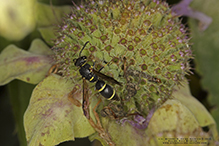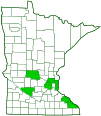Pennsylvania mason wasp
(Parancistrocerus pensylvanicus)
Conservation • Description • Habitat • Ecology • Distribution • Taxonomy
Conservation Status |
|
|||||||
| IUCN Red List | not listed |
|||||||
| NatureServe | not listed |
|||||||
| Minnesota | not listed |
|||||||
Description |
||
Pennsylvania mason wasp is a small predatory wasp. It occurs in the United States from Maine to Maryland, west to Minnesota and Iowa, and in southern Canada from Nova Scotia west to Alberta. Wasp size is often given in terms of the length of the forewing. The female has a forewing length of 3⁄16″ to ¼″ (5.0 to 7.0 mm). The body is black with bright yellow or ivory markings. The description below is of the more common yellow form. The front part of the body (mesosoma) is connected to the rear part (metasoma) by a narrow waist (petiole). The head is black. There are two large compound eyes, one on each side of the head, and three small simple eyes (ocelli) in a triangular pattern at the top of the head between the compound eyes. The inner margin of each compound eye is notched. The middle ocellus is not bordered with a fine, eyelid-like crease at the rear. The antennae are thread-like and have 13 segments, including a long first segment (scape) at the base, a short second segment (pedicel), and a whip-like section (flagellum) with 11 segments (flagellomeres). The upper side of all antennal segments is black. The underside of the scape is yellow. The underside of the pedicel and each flagellum is yellowish-brown. The last flagellum is not hooked at the tip. The jaws (mandibles) are long and knife-like. The plate on the face (clypeus) is usually entirely black, but sometimes there is a pair of yellow spots on the upper lateral margins. There is a yellow spot on the head between the antennae bases, and a small, yellow, dash-like spot (postocular spot) behind each compound eye. The thorax is black and has three segments, the prothorax, mesothorax, and metathorax. However, the first segment of the abdomen (propodeum) is fused to the thorax, giving the thorax the appearance of having four segments. The upper plate on the prothorax (pronotum) is short and collar-like. It does not have a narrow transverse ridge (carina). It extends rearward on the sides to the plate at the base of each wing (tegula). It appears horseshoe-shaped when viewed from above, triangular when viewed from the side. It is mostly black except for a yellow band on the front margin of the upper (dorsal) surface. The band is widest toward the middle and tapers narrowly to each side. It is always interrupted in the middle, and it is sometimes interrupted on both sides, forming four separated spots. On the forward facing surface of the pronotum, just behind the head, there is a pair of deep pits. On the mesothorax, the large front plate (mesoscutum or scutum), and the smaller rear plate (scutellum) are both entirely black, with no yellow markings. The scutum has two small projections at the rear corners called parategula, a feature common to all potter or mason wasps (family Eumeninae). The tegula touches the parategula at the tip. On the upper surface of the metathorax (metanotum) there is a straight, horizontal, yellow line. There is a small yellow spot at the base of each forewing and a larger yellow spot on the side of the thorax below the wing bases. The first and second abdominal segments form a petiole that connect the abdomen to the thorax. The metasoma has six segments. The first segment is wider than long and only half as long as the second segment. It is black with a yellow band at the rear. The second segment is almost as long as the remaining segments combined. It always has a yellow band at the rear, and it sometimes has a small yellow spot on each side. There is a smooth depression at the base that serves as a shelter for beneficial mites. The mites feed on fungi in the wasp’s nest, fungi that would otherwise harm the offspring or their provisions. There are no parallel ridges at the end of the second segment. The third through fifth segments have a narrow yellow band at the rear. However, the band on the third segment is usually interrupted, reduced to two spots, or absent. It is rarely complete. The sixth segment is entirely black. The wings are smoky brown with dark veins. On the forewing, the first discoidal cell is very long, about half the total length of the wing. There are three submarginal cells. The legs are black and yellow. The first segment (trochanter) is not divided – it has just one segment. On each leg the third segment (femur) is mostly black, yellow just at the tip, and the fourth segment (tibia) is yellow above, black below. The tibiae on the middle leg has a single spur at the tip. The last part of each leg (tarsus), corresponding to the foot, has five segments. There is a pair of claws at the tip of each tarsus. The claws are split (cleft) at the end. The male is similar but smaller, with a 3⁄16″ to ¼″ (5.0 to 6.5 mm) forewing length. The markings on the body are often pale yellow. The antennae have just 12 segments. The underside of the flagellomeres are yellow, and the last flagellum is hooked at the tip. The clypeus is usually entirely yellow, but the front margin is sometimes black on the sides. The metasoma has seven visible segments. The second segment does not have a small yellow spot on each side. The third through fifth or sixth segments have a narrow yellow band at the rear. The seventh segment is entirely black. The femurs on the middle leg has a distinct depression on the underside in the basal third. |
||
Size |
||
Female forewing length: 3⁄16″ to ¼″ (5.0 to 7.0 mm) Male forewing length: 3⁄16″ to ¼″ (5.0 to 6.5 mm) |
||
Similar Species |
||
Habitat |
||
|
||
Ecology |
||
Season |
||
|
||
Behavior |
||
|
||
Life Cycle |
||
The female creates a nest in a boring in a twig. |
||
Larva Hosts |
||
Caterpillars of the moth family Tortricidae. |
||
Adult Food |
||
|
||
Distribution |
||||
|
Sources |
|||
| 3/21/2023 | ||||
Occurrence |
||||
|
||||
Taxonomy |
|||
Order |
Hymenoptera (Ants, Bees, Wasps, and Sawflies) | ||
Suborder |
Apocrita (Narrow-waisted Wasps, Ants, and Bees) | ||
| No Rank | Aculeata (Ants, Bees, and Stinging Wasps) | ||
Superfamily |
Vespoidea (vespoid wasps) | ||
Family |
Vespidae (hornets, paper wasps, potter wasps, and allies) |
||
Subfamily |
Eumeninae (potter and mason wasps) | ||
Genus |
Parancistrocerus | ||
Synonyms |
|||
|
|||
Common Names |
|||
Pennsylvania mason wasp |
|||
Glossary
Clypeus
On insects, a hardened plate on the face above the upper lip (labrum).
Femur
On insects and arachnids, the third, largest, most robust segment of the leg, coming immediately before the tibia. On humans, the thigh bone.
Flagellomere
A segment of the whip-like third section of an insect antenna (flagellum).
Mesosoma
In Hymenoptera: the front part of the body, consisting of all three segments of the thorax and the first segment of the abdomen, to which the wings are attached.
Metasoma
In Hymenoptera: the armored rear part of the body, consisting of the second segment of the abdomen and all segments posterior to it.
Pedicel
On plants: the stalk of a single flower in a cluster of flowers. On insects: the second segment of the antennae. On Hymenoptera and Araneae: the narrow stalk connecting the thorax to the abdomen: the preferred term is petiole.
Petiole
On plants: The stalk of a leaf blade or a compound leaf that attaches it to the stem. On ants and wasps: The constricted first one or two segments of the rear part of the body.
Pronotum
The exoskeletal plate on the upper side of the first segment of the thorax of an insect.
Propodeum
In Hymenoptera: the last segment of the thorax, anatomically the first segment of the abdomen.
Scape
In plants: An erect, leafless stalk growing from the rootstock and supporting a flower or a flower cluster. In insects: The basal segment of the antenna.
Tarsus
On insects, the last two to five subdivisions of the leg, attached to the tibia; the foot. On spiders, the last segment of the leg. Plural: tarsi.
Tegula
A small, hardened, plate, scale, or flap-like structure that overlaps the base of the forewing of insects in the orders Lepidoptera, Hymenoptera, Diptera, and Homoptera. Plural: tegulae.
Tibia
The fourth segment of an insect leg, after the femur and before the tarsus (foot). The fifth segment of a spider leg or palp. Plural: tibiae.
Visitor Photos |
|||||
Share your photo of this insect. |
|||||
| This button not working for you? Simply email us at info@MinnesotaSeasons.com. Attach one or more photos and, if you like, a caption. |
|||||
Alfredo Colon |
|||||
 |
|||||
MinnesotaSeasons.com Photos |
|||||
|
|||||

Slideshows |
||

Visitor Videos |
|||
Share your video of this insect. |
|||
| This button not working for you? Simply email us at info@MinnesotaSeasons.com. Attach a video, a YouTube link, or a cloud storage link. |
|||
Other Videos |
|||

Created: 3/21/2023
Last Updated:


